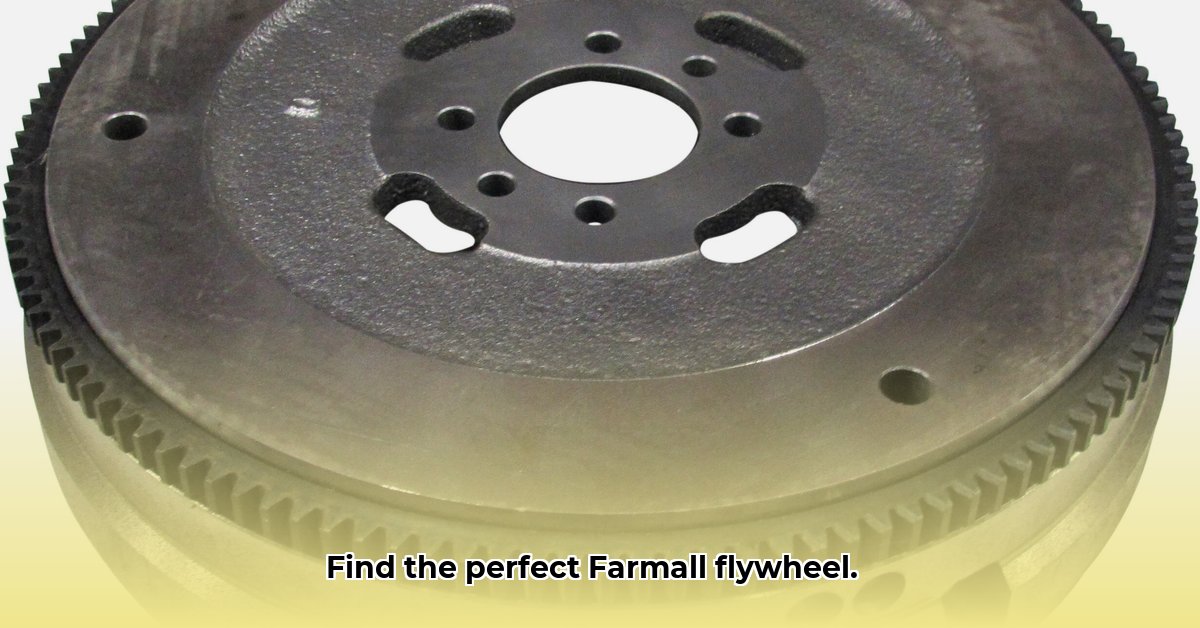
Your Farmall tractor's flywheel is a critical component, essential for smooth engine operation. A malfunctioning flywheel can lead to reduced performance, increased fuel consumption, and even major engine damage. Replacing a faulty flywheel can seem daunting, given the variations in part numbers, specifications, and supplier offerings. This comprehensive guide simplifies the process, empowering you to choose and (with professional assistance, where needed) install the correct replacement. For more information on Farmall tractors, see this helpful resource: 1950 Farmall info.
Understanding Farmall Flywheel Specifications
The flywheel serves as the engine's energy reservoir, smoothing out power delivery and preventing stalls. Selecting the correct replacement requires careful attention to several key specifications. These specifications are crucial for ensuring compatibility with your tractor's clutch system and avoiding costly mistakes.
Part Number: This alphanumeric code is the most direct identifier of a specific flywheel. Locate this number on the old flywheel or in your tractor's service manual. This number is your key to finding a perfect match.
Dimensions: Precise measurements of diameter and thickness are critical. Even slight variations can prevent proper installation or lead to clearance issues.
Number of Teeth: The flywheel's ring gear meshes with the clutch. An incorrect tooth count will result in clutch slippage, damage, and potential engine failure. Confirm this number matches your tractor's requirements.
Material and Construction: Flywheels are typically made of cast iron or steel. The material and its construction significantly impact durability and longevity.
Comparing Flywheel Suppliers: A Comparative Analysis
Several suppliers provide Farmall tractor flywheels, each differing in price, part availability, and service offerings. Consider factors beyond price alone when choosing a supplier. A seemingly cheaper part might end up costing more in the long run due to poor quality or incompatibility.
We'll examine two prominent suppliers, although additional suppliers exist and should be included in your research:
| Supplier | Price Range | Part Availability | Clutch Compatibility Focus | Additional Services | Customer Service Reputation |
|---|---|---|---|---|---|
| Yesterday's Tractors | $50 - $1000+ (estimated) | Generally Wide | Moderate | Usually None | Varies |
| WaterStractor | Varies widely (estimated) | Varies | High | Potential Machining Services | Often praised for expertise |
Note: Price ranges and availability are estimates and subject to change. Always verify current pricing and stock levels directly with the supplier. Consult additional suppliers to broaden your options and comparisons.
Isn't it crucial to consider more than just the initial cost of a part? How much could a faulty part really cost you in the long run, considering potential repairs and downtime?
Choosing the Right Flywheel: A Step-by-Step Process
Selecting the correct replacement flywheel involves a methodical approach:
Identify Tractor Model and Year: This is foundational, as parts compatibility varies greatly across models and years.
Locate Original Part Number: The original part number is the most reliable way to identify the correct replacement.
Consult Multiple Suppliers: Cross-reference part numbers and prices across at least three reputable suppliers. This allows for informed comparison-shopping.
Verify Dimensions and Specifications: Carefully check all reported dimensions against your tractor's specifications to ensure a perfect fit. Even slight discrepancies can be problematic.
Confirm Clutch Compatibility: A critical step – ensure the flywheel is compatible with your tractor's clutch mechanism to prevent slippage and damage.
Read Customer Reviews: Online reviews can offer valuable insight into the quality and reliability of the supplier and the specific flywheel in question. The experiences of other users are invaluable.
Place Your Order: Once you've verified all aspects thoroughly, proceed with your purchase.
Flywheel Installation: When to Seek Professional Assistance
Installing a flywheel is a complex procedure requiring specialized tools and mechanical expertise. Unless you possess significant mechanical experience, it is strongly recommended to engage a qualified mechanic for installation. Improper installation can lead to serious damage to your engine, and attempting the job yourself may place you at risk. Remember, safety and proper installation are paramount and outweigh the cost of professional assistance.
Flywheel Maintenance and Troubleshooting
Regular inspection is key to preventing major issues. Periodically check for cracks, excessive wear, or any signs of damage. Address any problems promptly. Proactive maintenance extends the lifespan of your flywheel and minimizes the risk of costly repairs.
Conclusion: Ensuring Optimal Tractor Performance
Selecting and installing the correct Farmall tractor flywheel requires a meticulous approach. By carefully following the steps outlined in this guide and prioritizing quality and compatibility over immediate cost savings, you significantly enhance your tractor's reliability, performance, and longevity. Remember, seeking professional assistance for installation is always the safest course of action for most users.